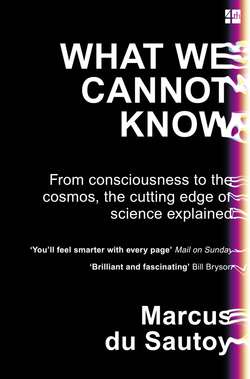Читать книгу What We Cannot Know: Explorations at the Edge of Knowledge - Marcus Sautoy du - Страница 32
LIFE: A CHANCE THROW OF THE DICE?
ОглавлениеMay’s pioneering research explored the dynamics of a population as it went from season to season. But what determines which animals survive and which die before reproducing? According to Darwin, this is simply down to a lucky roll of the evolutionary dice.
The model of the evolution of life on Earth is based on the idea that once you have organisms with DNA, then the offspring of these organisms share the DNA of their parent organisms. But parts of the genetic code in the DNA can undergo random mutations. These are essentially down to the chance throw of the evolutionary dice. But there is a second important strand to Darwin’s proposal, which is the idea of natural selection.
Some of those random changes will give the offspring an increased chance of survival, while other changes will result in a disadvantage. The point of evolution by natural selection is that it is more likely that the advantageous change will survive long enough to reproduce.
Suppose, for example, that I start with a population of giraffes that have short necks. The environment of the giraffes changes such that there is more food in the trees, so that any giraffe born with a longer neck is going to have a better chance of survival. Let’s suppose that I throw my Vegas dice to determine the chance of a mutation for each giraffe born in the next generation following this environmental change. A roll of a 1, 2, 3, 4 or 5 condemns the giraffe to a neck of the same size or shorter, while a throw of a 6 corresponds to a chance mutation which causes a longer neck. The lucky longer-necked giraffes get the food and the shorter-necked giraffes don’t survive to reproduce. So it is just the longer-necked giraffes that get the chance to pass on their DNA.
In the next generation the same thing happens. Roll a 1, 2, 3, 4 or 5 on the dice and the giraffe doesn’t grow any taller than its parents. But another 6 grows the giraffe a bit more. The taller giraffes survive again. The environment favours the giraffes that have thrown a 6. Each generation ends up a bit taller than the last generation until there comes a point where it is no longer an advantage to grow any further.
It’s the combination of chance and natural selection that results in us seeing more giraffes with ancestors that all threw 6s. In retrospect it looks like amazing chance that you see so many 6s in a row. But the point is that you don’t see any of the other rolls of the dice because they don’t survive. What looks like a rigged game is just the result of the combination of chance and natural selection. There is no design or fixing at work. The run of consecutive 6s isn’t a lucky streak but is actually the only thing we would expect to see from such a model.
It’s a beautifully simple model, but, given the complexity of the changes in the environment and the range of mutations that can occur, this simple model can produce extraordinary complexity, which is borne out by the sheer variety of species that exist on Earth. One of the reasons I never really fell in love with biology is that there seemed to be no way to explain why we got cats and zebras out of this evolutionary model and not some other strange selection of animals. It all seemed so arbitrary. So random. But is that really fair?
There is an interesting debate going on in evolutionary biology about how much chance there is in the outcomes we are seeing. If we rewound the story of life on Earth to some point in the past and threw the dice again, would we see very similar animals appearing or could we get something completely different? It is the question that May raised at the end of our lunch.
It does appear that some parts of evolution seem inevitable. It is striking that throughout evolutionary history the eye evolved independently 50 to 100 times. This is strong evidence for the fact that the different rolls of the dice that have occurred across different species seem to have produced species with eyes regardless of what is going on around them. Lots of other examples illustrate how some features, if they are advantageous, seem to rise to the top of the evolutionary swamp. This is illustrated every time you see the same feature appearing more than once in different parts of the animal kingdom. Echolocation, for example, is used by dolphins and bats, but they evolved this trait independently at very different points on the evolutionary tree.
But it isn’t clear how far these outcomes are guaranteed by the model. If there is life on another planet, will it look anything like the life that has evolved here on Earth? This is one of the big open questions in evolutionary biology. As difficult as it may be to answer, I don’t believe it qualifies as something we can never know. It may remain something we will never know, but there is nothing by its nature that makes it unanswerable.
